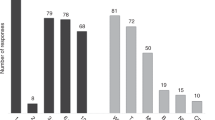Abstract
To evaluate the origin of cells after allogeneic haematopoietic stem cell transplantation we optimised and evaluated two commercially available systems (AmpFlSTR Profiler Plus and GenePrint Powerplex-16) which are based on multiplex fluorescent short tandem repeat (STR) analysis. A standard procedure for interpretation of electropherographs was found essential to obtain reproducible results. On the basis of the relative length of donor and recipient alleles, TYPE-I (no shared alleles are used to calculate chimerism), TYPE-II (one shared and one unshared allele is used to calculate chimerism) or TYPE-III (not informative) allelic distribution types were distinguished. Also, stutter peaks were recognised as an important criterion to exclude a marker for analysis. Intralaboratory and multicentre evaluation of the AmpFlSTR Profiler Plus system showed that mixed blood samples could be determined with an absolute deviation of less than 2%. A sensitivity threshold was set at 5% for TYPE-I and 10% for TYPE-II markers since relative imprecision increases at low chimerism values. No significant difference of calculated chimerism values was observed between STR markers shared between both systems. By monitoring 26 allogeneic peripheral blood stem cell transplants, the applicability of the proposed method was demonstrated. Bone Marrow Transplantation (2001) 28, 511–518.
This is a preview of subscription content, access via your institution
Access options
Subscribe to this journal
Receive 12 print issues and online access
$259.00 per year
only $21.58 per issue
Buy this article
- Purchase on Springer Link
- Instant access to full article PDF
Prices may be subject to local taxes which are calculated during checkout







Similar content being viewed by others
References
Bennett P . Demystified … microsatellites Mol Pathol 2000 53: 177–183
Childs R, Clave E, Contentin N et al. Engraftment kinetics after nonmyeloablative allogeneic peripheral blood stem cell transplantation: full donor T-cell chimerism precedes alloimmune responses Blood 1999 94: 3234–3241
Sambrook J, Fritsch EF, Maniatis T . Molecular Cloning: a Laboratory Manual Cold Spring Harbor Laboratory: New York 1989
Walsh PS, Fildes NJ, Reynolds R . Sequence analysis and characterization of stutter products at the tetranucleotide repeat locus vWA Nucleic Acids Res 1996 24: 2807–2812
Applied-Biosystems AmpFlSTR Profiler Plus PCR Amplification Kit User's Manual 1998
Thiede C, Florek M, Bornhauser M et al. Rapid quantification of mixed chimerism using multiplex amplification of short tandem repeat markers and fluorescence detection Bone Marrow Transplant 1999 23: 1055–1060
Nuckols JD, Rasheed BK, McGlennen RC et al. Evaluation of an automated technique for assessment of marrow engraftment after allogeneic bone marrow transplantation using a commercially available kit Am J Clin Pathol 2000 113: 135–140
Thiede C, Bornhäuser M, Oelschlägel U et al. Sequential monitoring of chimerism and detection of minimal residual disease after allogeneic blood stem cell transplantation (BSCT) using multiplex PCR amplification of short tandem repeat-markers Leukemia 2001 15: 293–302
Scharf SJ, Smith AG, Hansen JA et al. Quantitative determination of bone marrow transplant engraftment using fluorescent polymerase chain reaction primers for human identity markers Blood 1995 85: 1954–1963
Frankel W, Chan A, Corringham RE et al. Detection of chimerism and early engraftment after allogeneic peripheral blood stem cell or bone marrow transplantation by short tandem repeats Am J Hematol 1996 52: 281–287
Pindolia K, Janakiraman N, Kasten-Sportes C et al. Enhanced assessment of allogeneic bone marrow transplant engraftment using automated fluorescent-based typing Bone Marrow Transplant 1999 24: 1235–1241
Zhou M, Sheldon S, Akel N, Killeen AA . Chromosomal aneuploidy in leukemic blast crisis: a potential source of error in interpretation of bone marrow engraftment analysis by VNTR amplification Mol Diagn 1999 4: 153–157
De Weger RA, Tilanus MG, Scheidel KC et al. Monitoring of residual disease and guided donor leucocyte infusion after allogeneic bone marrow transplantation by chimaerism analysis with short tandem repeats Br J Haematol 2000 110: 647–653
Zetterquist H, Mattsson J, Uzunel M et al. Mixed chimerism in the B cell lineage is a rapid and sensitive indicator of minimal residual disease in bone marrow transplant recipients with pre-B cell acute lymphoblastic leukemia Bone Marrow Transplant 2000 25: 843–851
Acknowledgements
We thank Pascale Cochaux, Pieter De Schouwer, Dominique Latinne and Frans Houtmeyers for their contribution to the multicenter study. This study was supported by the ‘Wetenschappelijk Fonds Hematologie v.z.w., AZ Sint-Jan AV’.
Author information
Authors and Affiliations
Rights and permissions
About this article
Cite this article
Nollet, F., Billiet, J., Selleslag, D. et al. Standardisation of multiplex fluorescent short tandem repeat analysis for chimerism testing. Bone Marrow Transplant 28, 511–518 (2001). https://doi.org/10.1038/sj.bmt.1703162
Received:
Accepted:
Published:
Issue Date:
DOI: https://doi.org/10.1038/sj.bmt.1703162
Keywords
This article is cited by
-
Evaluation of a quantitative PCR-based method for chimerism analysis of Japanese donor/recipient pairs
Scientific Reports (2022)
-
A SNP panel for early detection of artificial chimerism in HSCT patients using TaqMan technology
International Journal of Legal Medicine (2020)
-
A phase II clinical trial of adoptive transfer of haploidentical natural killer cells for consolidation therapy of pediatric acute myeloid leukemia
Journal for ImmunoTherapy of Cancer (2019)
-
Multiplex STR panel for assessment of chimerism following hematopoietic stem cell transplantation (HSCT)
Annals of Hematology (2019)
-
All mixed up?—genotype change after stem cell transplantation impeded verification of 21-year-old semen sample—a case report
International Journal of Legal Medicine (2019)



